Indicator scoreboardEMU — March merchandise trade surplus with the rest of the world was €9.1 billion, more than triple the surplus a year ago. February's trade balance was revised up to a surplus of €5.5 billion from an originally reported surplus of €4.1 billion. Exports fell 3 percent and imports were down 10 percent when compared with last year. Germany — First quarter seasonally and calendar adjusted gross domestic product edged up 0.2 percent but was down 1.2 percent when compared with last year. GDP rose due to a sharp rise in net exports, but the domestic economy remained very weak. All other major categories posted declines with domestic demand plunging 1.4 percent. Consumer spending fell for the third quarter in a row, while total investment declined for the sixth quarter in a row. GDP had declined in the third and fourth quarters of 2001. 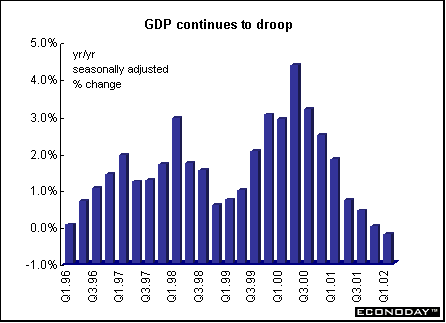 France — April seasonally adjusted consumer spending on manufactured goods rose 0.8 percent and was up 4.2 percent when compared with last year. Auto sales led the gains, up 2.9 percent and 9.0 percent on the year. Autos offset a 2.0 percent drop in household durables spending, helping overall durable goods spending to rise 0.2 percent on the month and 5.2 percent higher on the year. Even excluding the auto sector (and medical products), spending was up 0.4 percent on the month and 2.8 percent on the year. First quarter seasonally and workday adjusted gross domestic product rose 0.4 percent and 0.3 percent when compared with last year. The fourth quarter decline was revised to a 0.4 percent drop from the 0.3 percent drop previously reported. Private consumption rose a meager 0.2 percent and business investment crawled up 0.1 percent.  Italy — March industrial orders fell 3.5 percent when compared with last year. Domestic orders, which account for around 62 percent of the overall index, sank 5.4 percent while foreign orders, which account for about 37 percent, fell 0.5 percent. Industrial orders have now posted eleven declines in the last twelve months. Five of 10 product sectors dropped. April merchandise trade surplus was €39 million, compared with a surplus of €314 million in April 2001. April non-EU exports fell 4.0 percent while imports dropped 1.3 percent. The merchandise trade balance with non-EU countries also worsened substantially compared with the year before as the fall in exports outstripped the drop in imports. EU exports fell in March by 11.2 percent on the year, while imports declined 8.7 percent. Britain — April retail price index rose 0.4 percent and 1.5 percent when compared with last year. A sharp decline in seasonal foods offset increased energy prices. The retail price index excluding mortgage interest payments rose 0.7 percent and was up 2.3 percent on the year. 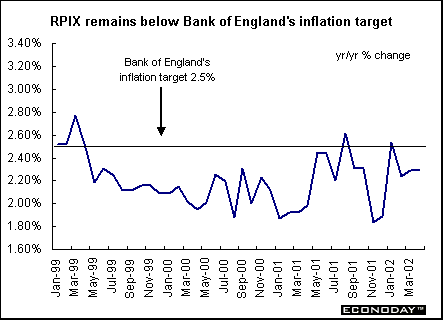 April seasonally adjusted retail sales volumes rose 1.7 percent and 6.9 percent when compared with last year. Non-food sales volumes jumped 2.4 percent while non-store retailing and repair sales rocketed 8.7 percent. Textile, clothing and footwear sales were up 4.7 percent on the month. 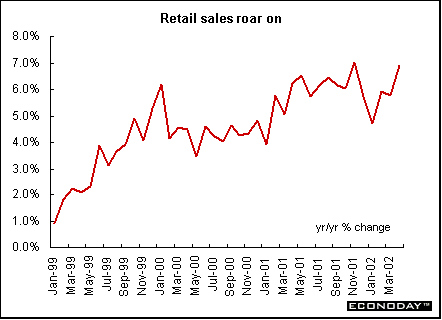 First quarter business investment fell 1.1 percent and was 3.4 percent below levels a year earlier. Business investment by private- and public-sector manufacturing fell 3.1 percent on the quarter and 12.3 percent on the year. First quarter gross domestic product was revised downward to show no growth from the 0.1 percent increase initially reported. When compared with last year, GDP rose 1.0 percent, unchanged from the earlier estimate. Service sector output was revised down to an increase of 0.2 percent on the quarter from 0.5 percent as the business services and finance component fell 0.2 percent. Household expenditures rose 0.7 percent on the quarter and 3.8 percent on the year. Output from production industries declined 1.5 percent and 5.6 percent on the year. Manufacturing output also fell 1.5 percent and was down 6.5 percent on the year. Though the economy has posted 39 successive quarters without a decline in overall growth, strength has been centered in services and not manufacturing, where output has been weak. 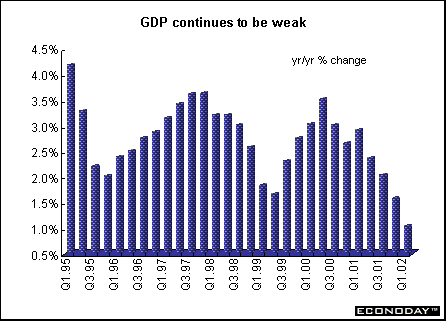 Asia Japan — March seasonally adjusted tertiary industry index rose 1.2 percent. For the three months to March, tertiary activity was grew 0.1 percent. The tertiary index reflects activity in six industries: utilities, transport and telecommunications, wholesale and retail, finance and insurance, real estate and services. The all industry index combines the tertiary index with activity in the construction, agricultural and fisheries industries, the public sector and industrial output also rose 1.2 percent. This index is considered a close approximation for gross domestic product growth as measured by industrial and service sector output. April seasonally adjusted merchandise trade surplus narrowed to ¥776.7 billion ($6.2 billion), from ¥1.06 trillion in March. Exports gained 0.3 percent, after a 2.4 percent rise in March. Slowing export growth is a key problem for Japan, which is relying on overseas demand to recover from 18 months of recession. Imports rose 9.1 percent, rebounding from an 8 percent decline in March and posting the biggest monthly increase since May 2000. From a year earlier, the April trade surplus widened to ¥836.7 billion from ¥660.9 billion. Exports rose 1.6 percent for the first year-on-year gain in 13 months. Imports fell 2.9 percent. By volume, exports rose 5 percent from a year ago and imports increased 2.1 percent. The trade surplus with the United States shrank 3.5 percent from a year ago as exports declined 5.2 percent. Imports from the United States fell 6.9 percent. Americas Canada — April unadjusted consumer price index rose 0.6 percent for the fifth consecutive monthly increase. The increase was driven largely by gasoline prices, which rose 6.8 percent. When compared with last year, the CPI rose 1.7 percent. The seasonally adjusted CPI rose 0.5 percent and was up 1.6 percent on the year. 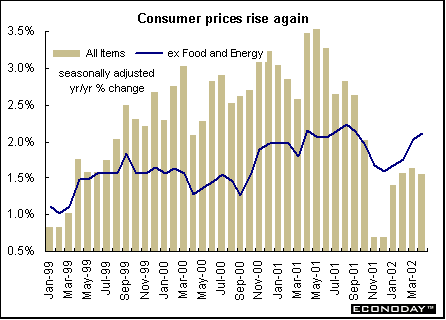 March retail sales slipped 0.2 percent but were up a strong 6.1 percent when compared with last year. Sales rose for drugs and furniture, while clothing sales fell 1.7 percent. All other sectors were essentially unchanged. In constant dollars, total retail sales fell 0.7 percent. 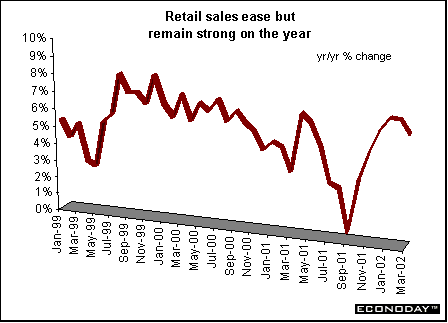 | ![[Back To Archive]](../../../images/backtoarchive.gif)